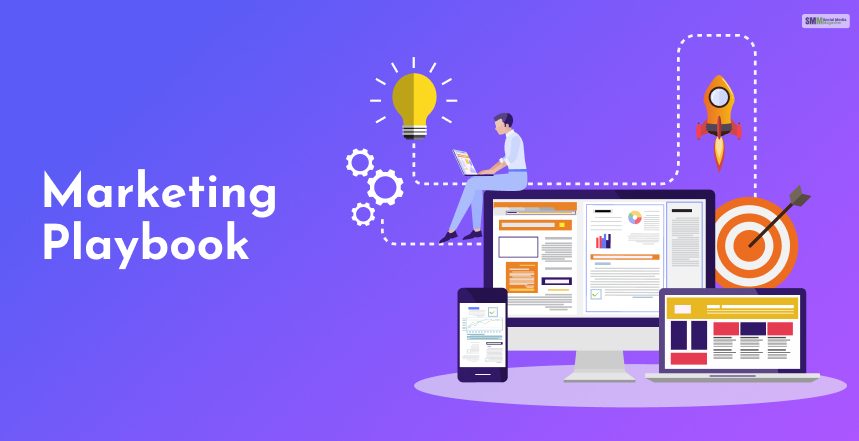How Gamers Use Social Media Proxies To Bypass Region Locks And Stream Gameplay?
Nabamita Sinha, 3 days ago

Nabamita Sinha, 3 days ago

Barsha Bhattacharya, 3 weeks ago


A marketing playbook is a comprehensive document or guide that outlines a company’s strategies, tactics, best practices, and processes related to marketing activities. It serves as a centralized resource, providing a structured framework for planning, executing, and optimizing marketing efforts.
Read this post till the end to learn how you can create a marketing playbook to drive your marketing strategy.
A marketing playbook typically consists of several components that guide a company’s marketing strategy. Here are five essential elements:

The playbook begins with the overarching marketing strategy. It defines the company’s goals, target audience, unique value proposition, and positioning within the market. This section sets the foundation for all marketing initiatives.
Detailed insights into the target audience, including demographics, psychographics, behaviors, and preferences. Understanding the audience helps tailor messaging and tactics to resonate with specific customer segments.

It includes brand elements such as logos, colors, fonts, brand voice, and messaging guidelines. Consistent branding across all marketing channels ensures a cohesive and recognizable brand identity.
Outlines the various channels (e.g., social media, email, content marketing, advertising) and specific tactics to reach the target audience effectively. It may include best practices for each channel and how they integrate into the overall strategy.

Details the types of content to be created, their purpose, distribution channels, and a content calendar. This encompasses blogs, videos, social media posts, eBooks, webinars, etc., aligning content wHow To Create A Marketing Playbookith the overall marketing goals.
Specific sections may focus on individual campaigns. These include campaign objectives, target audience segments, messaging, creative assets, timelines, and metrics to measure success.

Defines key performance indicators (KPIs) and measurement tools to track the effectiveness of marketing efforts. This section enables data-driven decision-making and provides insights for optimizing future strategies.
Provides ready-to-use templates, tools, and resources that streamline the execution of marketing activities. This could include email templates, social media calendars, design assets, etc.

A marketing playbook serves as a comprehensive guide that outlines strategies, tactics, and methodologies for executing marketing campaigns effectively. Here’s why it’s crucial:
A playbook ensures that all marketing efforts align with the brand’s overall strategy. It maintains consistency in messaging, branding, and customer experience across various channels and campaigns. This consistency builds brand recognition and trust among the audience.
By documenting proven strategies and tactics, a playbook streamlines processes. It saves time by providing a structured roadmap for implementing campaigns. Team members can refer to it for guidance, reducing guesswork and enabling efficient execution.
A playbook sets clear objectives and defines target audiences, helping marketers remain focused on their goals. It prevents distractions or deviation from the campaign’s core purpose, ensuring resources are utilized optimally.
While providing a structured framework, a playbook also allows for flexibility. Marketers can adapt strategies based on real-time data and market changes without losing sight of the overall marketing goals.
It serves as a central reference point for cross-functional teams. Sales, marketing, product, and other departments can align their efforts, ensuring everyone is on the same page regarding messaging, positioning, and campaign timelines.
A playbook encourages learning from past campaigns. By analyzing successes and failures, marketers can refine strategies and update the playbook accordingly. This iterative process fosters continuous improvement in marketing initiatives.
The playbook defines KPIs and measurement methods, ensuring that campaigns are measurable. This enables the team to track performance and be accountable for the outcomes, fostering a culture of data-driven decision-making.
Ultimately, a marketing playbook acts as a strategic blueprint, guiding the entire marketing team toward achieving specific objectives while maintaining brand integrity and adaptability in an ever-evolving landscape. It’s a foundational document that supports the success and growth of a company’s marketing efforts.

Creating a marketing playbook to drive campaigns involves several steps, which are as follows:
1. Set Clear Objectives: Define specific, measurable goals for your campaign. Whether it’s increasing brand awareness, driving sales, or expanding the customer base, clear objectives guide the entire playbook.
2. Understand Your Audience: Conduct thorough audience research to understand their needs, preferences, behaviors, and pain points. This insight helps tailor your campaign messaging and tactics.
3. Develop a Comprehensive Strategy: Integrate various components into your playbook—target audience analysis, brand strategy, marketing channels, content strategy, and metrics. Align these components to support your campaign’s objectives.
4. Choose the Right Channels and Tactics: Based on your audience insights and campaign goals, select the most suitable channels and tactics. This could involve social media, email marketing, content creation, influencer collaborations, PPC advertising, etc.
5. Create Compelling Content: Develop engaging and relevant content that resonates with your audience. This content should align with your brand messaging and be tailored to each chosen channel.
6. Implement and Monitor: Execute your campaign plan while closely monitoring its performance. Use analytics tools to track key metrics and make real-time adjustments as necessary.
7. Evaluate and Optimize: After the campaign, analyze the data collected to evaluate its success against the predefined KPIs. Identify what worked well and what didn’t, then use these insights to refine future campaigns.
A marketing playbook serves as a centralized reference that aligns the entire marketing team (and often extends to other departments) on the company’s marketing goals, strategies, and tactics. It evolves over time with insights gained from campaigns, market changes, and new trends, serving as a living document to guide and improve future marketing endeavors.
Each component interlinks to form a cohesive marketing strategy, providing a roadmap for how the brand communicates, engages, and grows within its market.
Remember, a marketing playbook is not static; it evolves based on market changes, audience feedback, and campaign outcomes. Regularly updating and improving the playbook ensures continued success in driving effective marketing campaigns.
Abdul Aziz Mondol is a professional blogger who is having a colossal interest in writing blogs and other jones of calligraphies. In terms of his professional commitments, he loves to share content related to business, finance, technology, and the gaming niche.